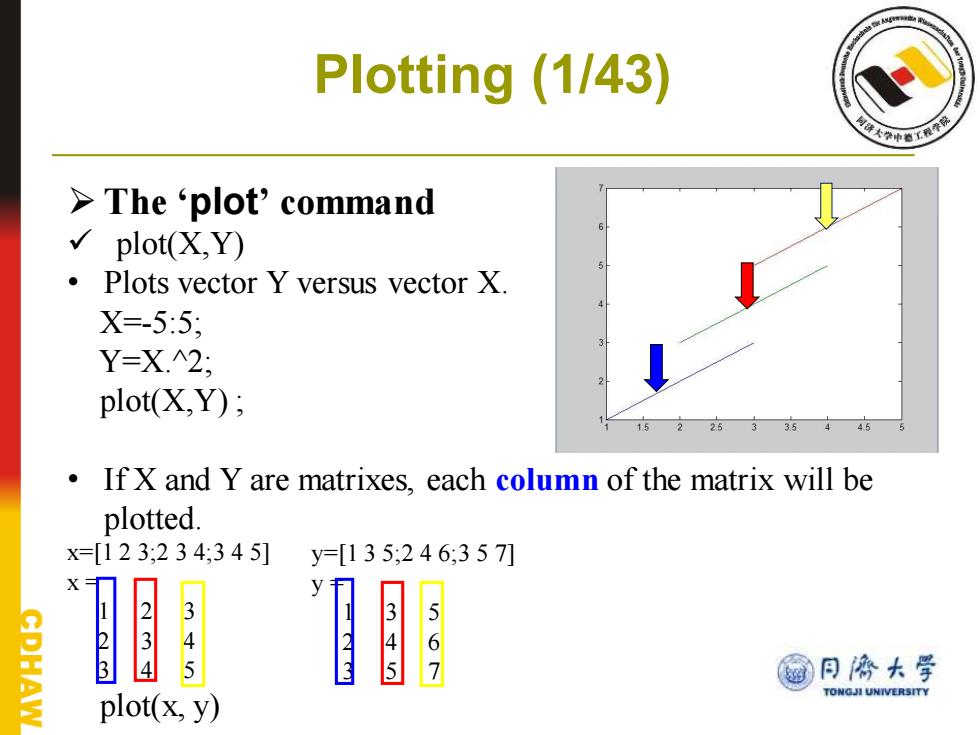
Plotting (1/43) >The‘plot'command √ plot(X,Y) 。 Plots vector Y versus vector X. X=5:5, Y=X.2; plot(X,Y); 25 35 If X and Y are matrixes,each column of the matrix will be plotted. x=[123,234;345] y=[135,246,357刀 345 23 345 56 7 @月济大学 TONGJI UNIVERSITY plot(x,y)
Plotting (1/43) ➢ The ‘plot’ command ✓ plot(X,Y) • Plots vector Y versus vector X. X=-5:5; Y=X.^2; plot(X,Y) ; • If X and Y are matrixes, each column of the matrix will be plotted. x=[1 2 3;2 3 4;3 4 5] x = 1 2 3 2 3 4 3 4 5 plot(x, y) y=[1 3 5;2 4 6;3 5 7] y = 1 3 5 2 4 6 3 5 7
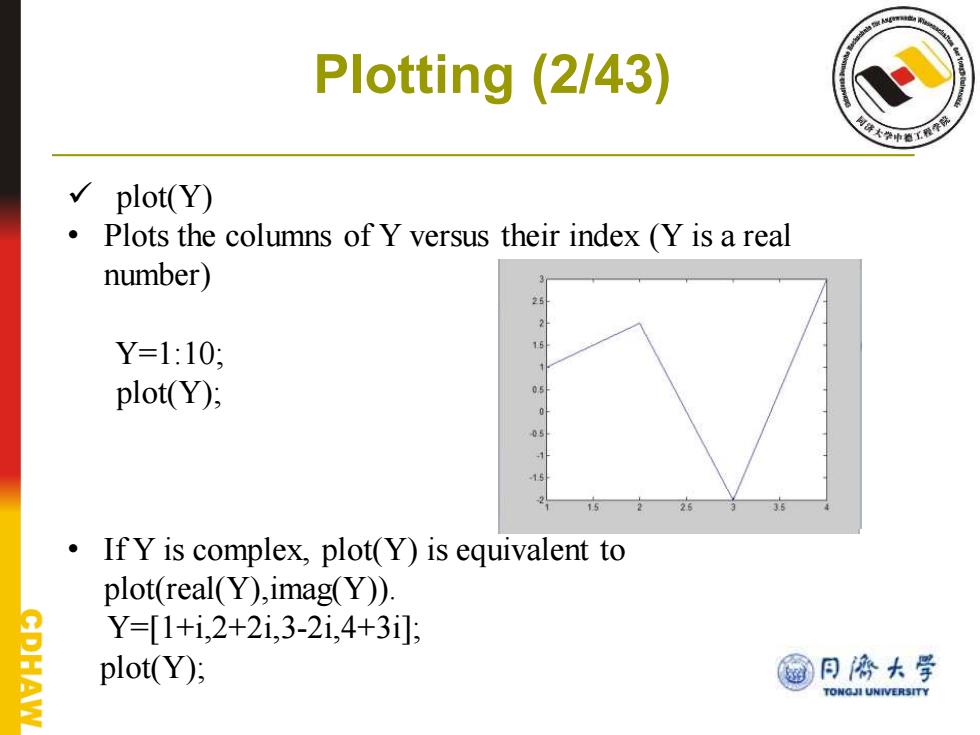
Plotting (2/43) plot(Y) Plots the columns of Y versus their index (Y is a real number) Y=1:10; plot(Y); If Y is complex,plot(Y)is equivalent to plot(real(Y),imag(Y)). Y=[1+i,2+2i,3-2i,4+3i]: plot(Y); @月协大学 TONGJI UNIVERSITY
Plotting (2/43) ✓ plot(Y) • Plots the columns of Y versus their index (Y is a real number) Y=1:10; plot(Y); • If Y is complex, plot(Y) is equivalent to plot(real(Y),imag(Y)). Y=[1+i,2+2i,3-2i,4+3i]; plot(Y);
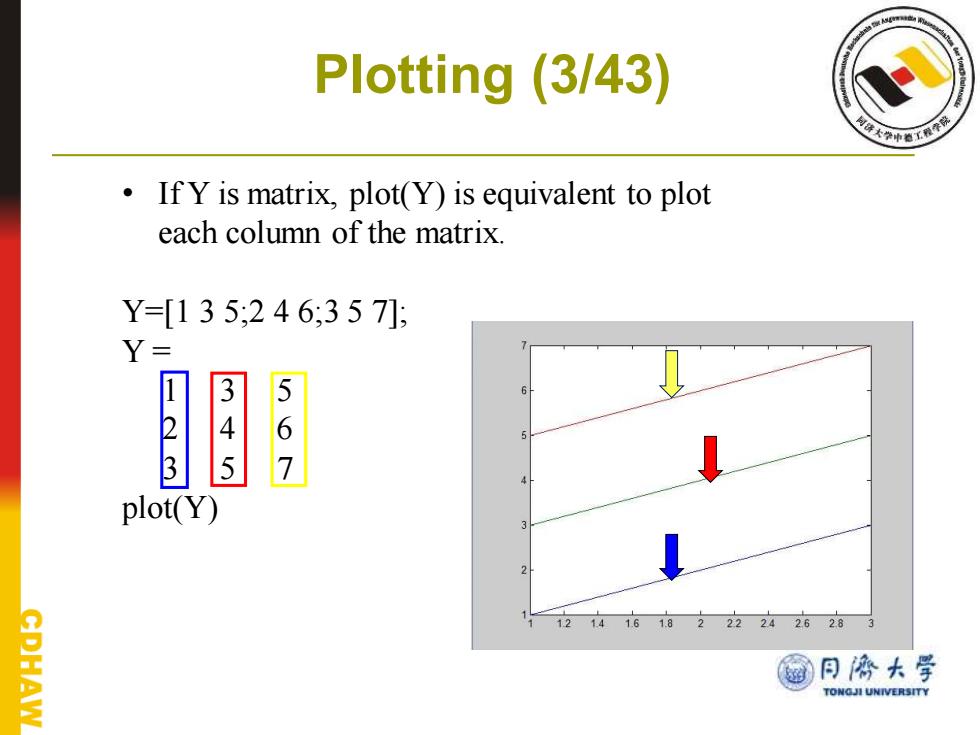
Plotting (3/43) If Y is matrix,plot(Y)is equivalent to plot each column of the matrix Y=[135;246,357] Y- 567 plot(Y) 12 1.4 1618222242628 翻日济大学 TONGJI UNIVERSITY
Plotting (3/43) • If Y is matrix, plot(Y) is equivalent to plot each column of the matrix. Y=[1 3 5;2 4 6;3 5 7]; Y = 1 3 5 2 4 6 3 5 7 plot(Y)
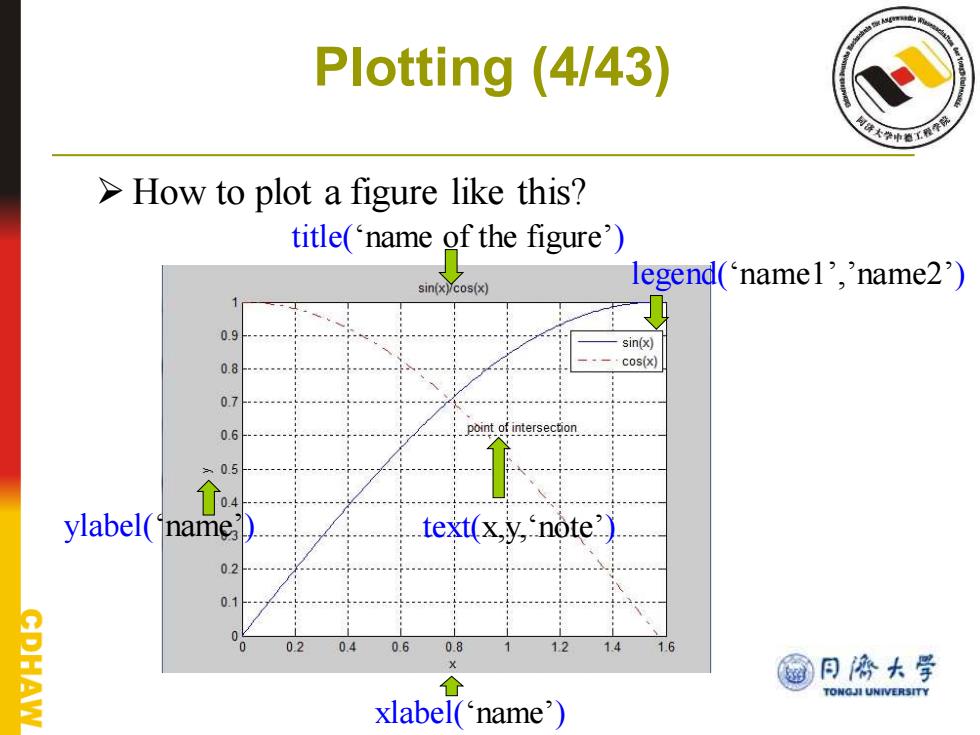
Plotting (4/43) >How to plot a figure like this? title(name of the figure') sin(x)cos(x) legend(namel','name2') 0.9 sin(x) 0.8 cos(x) 0.7 0.6 point of intersection 0.5 4 ylabel(name text(xy,note?) 02 CPHAW 0 0.2 0.4 0.6 0.8 12 1.6 @月停大学 TONGJI UNIVERSITY xlabel(name)
Plotting (4/43) ➢ How to plot a figure like this? title(‘name of the figure’) legend(‘name1’,’name2’) xlabel(‘name’) ylabel(‘name’) text(x,y,‘note’)
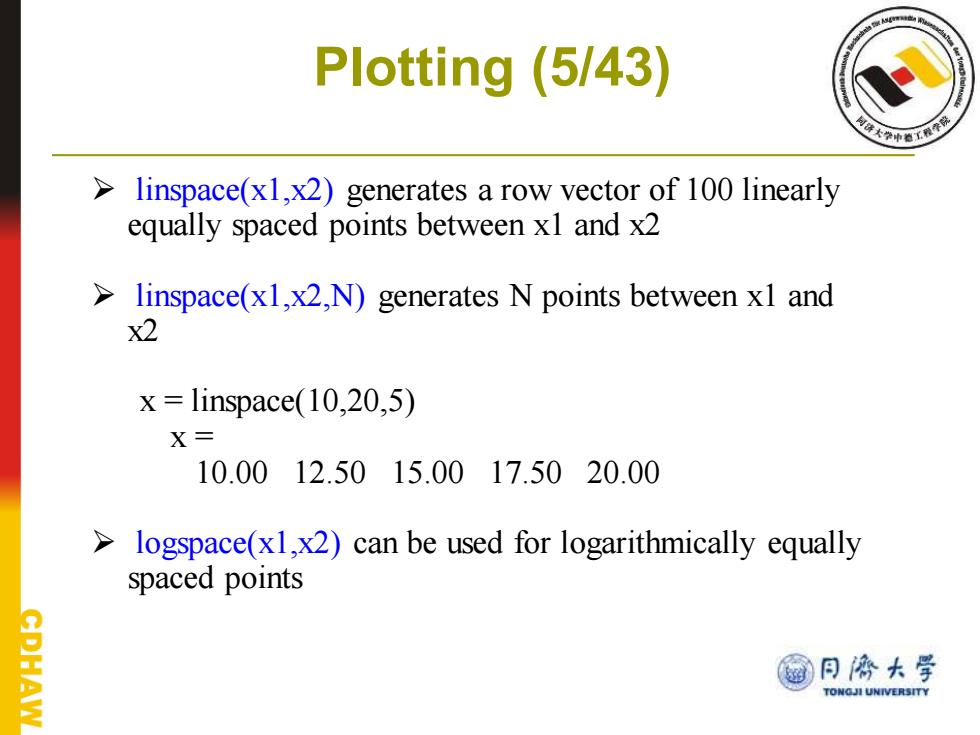
Plotting (5/43) linspace(x1,x2)generates a row vector of 100 linearly equally spaced points between x1 and x2 linspace(x1,x2,N)generates N points between x1 and x2 x linspace(10,20,5) X= 10.0012.5015.0017.5020.00 logspace(x1,x2)can be used for logarithmically equally spaced points PHAW 同濟大学 TONGJI UNIVERSITY
Plotting (5/43) ➢ linspace(x1,x2) generates a row vector of 100 linearly equally spaced points between x1 and x2 ➢ linspace(x1,x2,N) generates N points between x1 and x2 x = linspace(10,20,5) x = 10.00 12.50 15.00 17.50 20.00 ➢ logspace(x1,x2) can be used for logarithmically equally spaced points
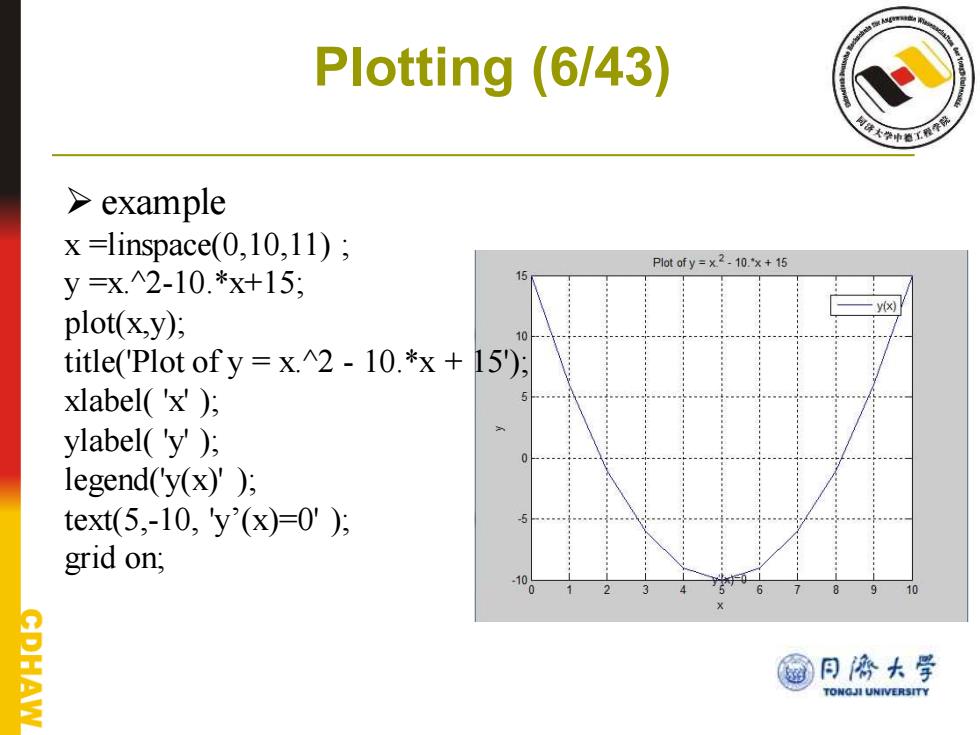
Plotting (6/43) example x =linspace(0,10,11); Plot of y =x2 -10.'x+15 y=x2-10.*x+15; y(x) plot(x,y); title('Plot of y x.2-10.*x+15); xlabel('x') ylabel('y') legend('y(x)'); text(5,-10,y(x)=0'); grid on; CPHAW @月协大学 TONGJI UNIVERSITY
Plotting (6/43) ➢ example x =linspace(0,10,11) ; y =x.^2-10.*x+15; plot(x,y); title('Plot of y = x.^2 - 10.*x + 15'); xlabel( 'x' ); ylabel( 'y' ); legend('y(x)' ); text(5,-10, 'y’(x)=0' ); grid on;
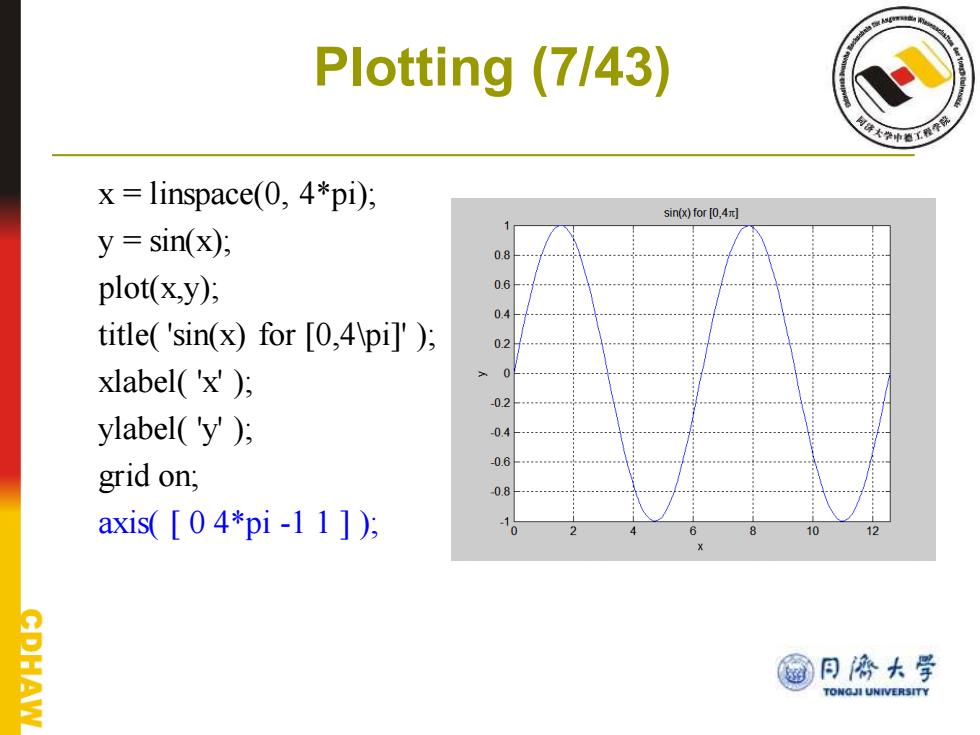
Plotting (7/43) x=linspace(0,4*pi); sin(x)for [0,4 y=sin(x); plot(x,y); 0.6 0.4 title('sin(x)for [0,4 pi]'); 02 xlabel('x') ylabel('y') 0.6 grid on; 0.8 axis([04*pi-11])月 0 12 @日济大学 AW TONGJI UNIVERSITY
Plotting (7/43) x = linspace(0, 4*pi); y = sin(x); plot(x,y); title( 'sin(x) for [0,4\pi]' ); xlabel( 'x' ); ylabel( 'y' ); grid on; axis( [ 0 4*pi -1 1 ] );
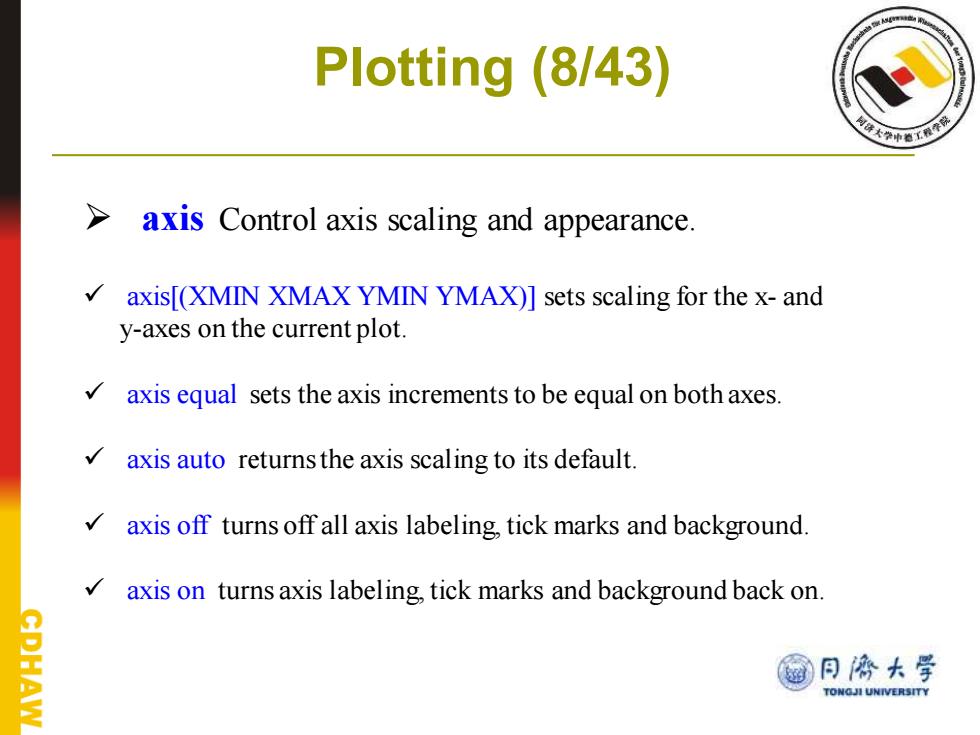
Plotting (8/43) axis Control axis scaling and appearance axis[(XMIN XMAX YMIN YMAX)]sets scaling for the x-and y-axes on the current plot. axis equal sets the axis increments to be equal on both axes. axis auto returns the axis scaling to its default. axis off turns off all axis labeling,tick marks and background. axis on turns axis labeling,tick marks and background back on @月诱大学 TONGJI UNIVERSITY
Plotting (8/43) ➢ axis Control axis scaling and appearance. ✓ axis[(XMIN XMAX YMIN YMAX)] sets scaling for the x- and y-axes on the current plot. ✓ axis equal sets the axis increments to be equal on both axes. ✓ axis auto returns the axis scaling to its default. ✓ axis off turns off all axis labeling, tick marks and background. ✓ axis on turns axis labeling, tick marks and background back on
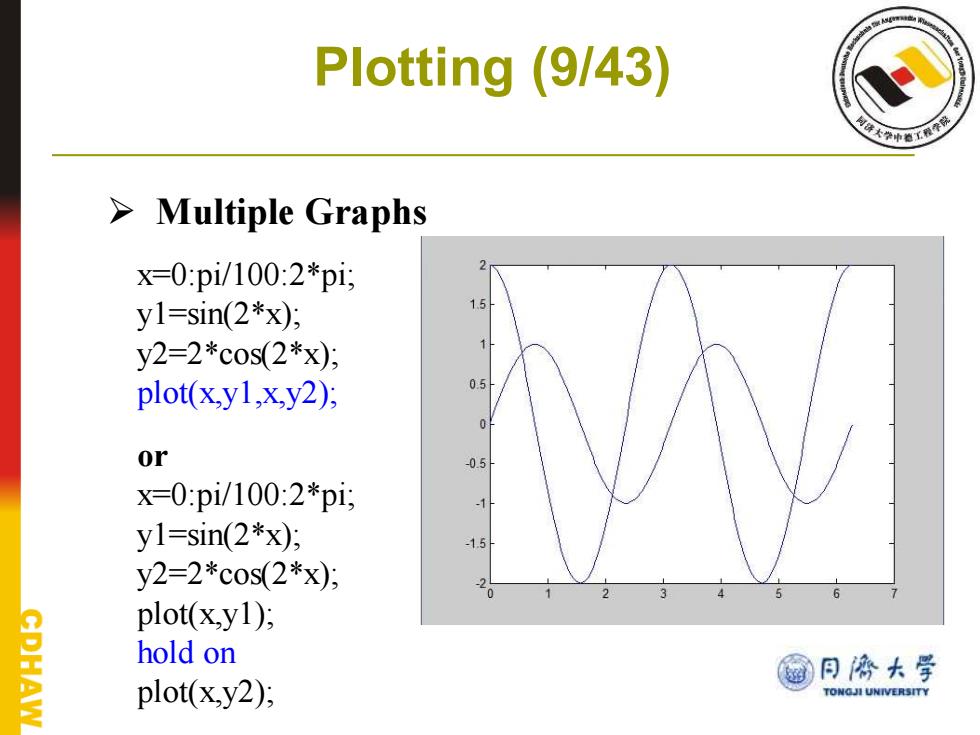
Plotting (9/43) a形 >Multiple Graphs x=0:pi/100:2*pi, y1=sin(2*x); y2=2*cos(2*x); plot(x.y1,x,y2); or x=0:pi/100:2*pi; y1=sin(2*x); y2=2*c0s(2*x); plot(x,y1); PHAW hold on @日济大学 plot(x.y2); TONGJI UNIVERSITY
Plotting (9/43) ➢ Multiple Graphs x=0:pi/100:2*pi; y1=sin(2*x); y2=2*cos(2*x); plot(x,y1,x,y2); or x=0:pi/100:2*pi; y1=sin(2*x); y2=2*cos(2*x); plot(x,y1); hold on plot(x,y2);
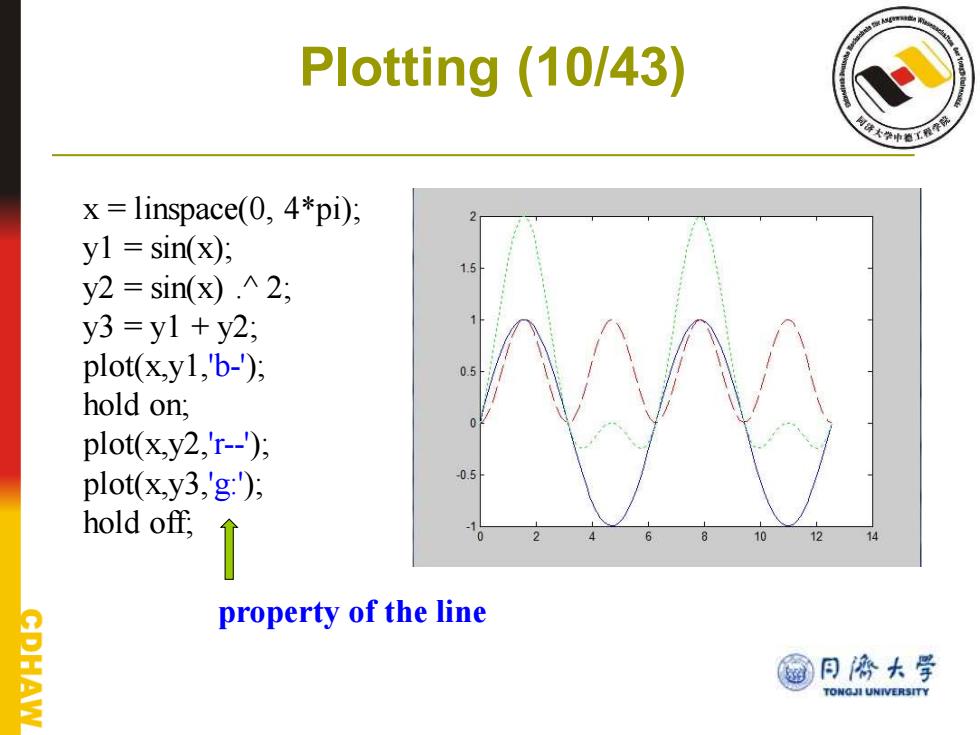
Plotting (10/43) x=linspace(0,4*pi); yl sin(x); y2=sin(x).^2; y3=y1+y2; plot(x,y1,'b-); hold on; plot(x.y2,'r--); plot(x,y3,'g:); hold off, ↑ 12 14 property of the line CDHAW @月协大学 TONGJI UNIVERSITY
Plotting (10/43) x = linspace(0, 4*pi); y1 = sin(x); y2 = sin(x) .^ 2; y3 = y1 + y2; plot(x,y1,'b-'); hold on; plot(x,y2,'r--'); plot(x,y3,'g:'); hold off; property of the line